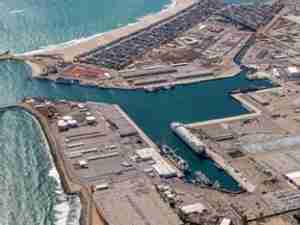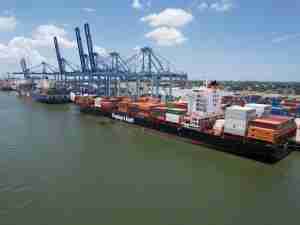Fitch Ratings has assigned an 'AA-' rating to the Port Authority of New York and New Jersey's (PANYNJ) approximately $1.0 billion in total series 221st and 222nd consolidated bonds.
Fitch maintains the following long-term obligations related to PANYNJ on Rating Watch Negative (RWN):
- $1.1 billion outstanding parity consolidated notes, series AAA 'AA-';
- Approximately $22.1 billion outstanding parity consolidated bonds 'AA-';
- 1WTC-2011 liberty revenue bonds, issued by the New York Liberty Development Corp., 'AA-';
- 4 World Trade Center Project Bonds, issued by the New York Liberty Development Corp., 'A';
- Approximately $2.25 billion of support payment obligations associated with 4 World Trade Center and Goethals Bridge 'A'.
Fitch has also affirmed PANYNJ's $750 million authorized commercial paper program at 'F1+'.
RATING RATIONALE
The RWN reflects the elevated stresses to both the agency's operating activities and revenue generation as a result of the novel coronavirus and related worldwide containment measures, which is resulting in sharply narrowing debt service coverage for 2020 and sustained pressures on reserve fund balances and capital funding options. The current environment also illustrates that PANYNJ's sizable fixed cost operating and debt service obligations have reduced its medium- to long-term financial flexibility over time, and that continued primarily debt-funded investment in future projects may be inconsistent with the 'AA' rating category. Recovery through the remainder of 2020 remains unpredictable, and further revenue and reserve pressures may emerge. The absence of improved activity levels over the near term, coupled with limitations to adjust operating costs and capital investments would likely continue to strain credit metrics on a sustained basis, resulting in a rating downgrade. Effective actions to adjust operating obligations and balance debt-funded capital investment with a meaningful level of pay-go that maintains significant financial flexibility will be important considerations in maintaining a 'AA' category rating level.
The 1 WTC-2011 rating reflects the fully pass through nature of debt service payments to PANYNJ. The short-term commercial paper notes rating reflect the maintenance of sufficient stand-alone unrestricted funds, together with external liquidity facilities, to cover outstanding notes balances. The payment obligation rating related to the Goethals Bridge and 4WTC projects is indicative of the lower pledge and security position relative to the consolidated bonds. The 4 WTC bonds rating reflects the financial support provided to the credit from PANYNJ in the form of its guarantee of debt service and from New York City (NYC; general obligation bonds rated AA/Negative) in the form of the city space lease. Fitch considers both NYC's and PANYNJ's obligations with respect to 4 World Trade Center, LLC (4 WTC) as being subordinate to the debt obligations of each agency, which is reflected in the rating on the series 2011 liberty revenue bonds.
KEY RATING DRIVERS
Summary: The ratings reflect PANYNJ's mature, diverse and monopolistic transportation infrastructure asset base, which provides critical service to the strong New York City metro area, supported further by a conservative debt structure. Its extensive capital plan, with a current assessment of $37 billion through 2026, with potential for continued adjustments, constrains the rating. Leverage remains somewhat moderate under Fitch's rating case, which takes into account revenue declines associated with the impact of coronavirus, and averages around 9.4x (senior) and 11.0x (total), but peaks in 2020 at 14.3x (senior) and 16.0x (total). Debt service coverage will face a substantial negative impact in 2020, falling well below historic levels. Non-operating revenues, including grants and CARES Act funds, are expected to become a larger portion of pledged funds supporting debt service. To the extent surplus net cashflow remains depressed, the ability to apply internally-sourced funds for capital spending will be constrained.
Resilient Revenue Base - Revenue Risk (Volume): Stronger
PANYNJ's portfolio of monopolistic, expansive and diverse transportation and real estate assets includes the four metro New York airports, interstate road, rail and ferry Hudson River crossings, and seaports. The region's diverse and populous economy as well as its status as a global center for commerce supports resilient demand and pricing power. Economic pricing flexibility may fall if World Trade Center (WTC) or Port Authority Trans-Hudson (PATH) transit assets underperform or if PANYNJ takes on additional loss-making assets.
Demonstrated Rate-Setting Flexibility - Revenue Risk (Price): Stronger
During normal economic cycles, PANYNJ benefits from strong airport cost recovery in airline use agreements and proactive toll increases on its bridges and tunnels with minimal impact on traffic levels. The steep reductions in activity volumes while the coronavirus period persists will put downward pressure on operating revenues in the absence of additional board actions.
Extensive Growing Capital Plan - Infrastructure Renewal & Development: Midrange
PANYNJ's latest 2017-2026 capital plan totals approximately $37 billion, up $4.8 billion from the prior $32.2 billion capital program initially established for this timeframe, and reflects additional values and reassessments related to key airport and rail projects. Other key projects cover bridges and tunnel works and a replacement bus terminal, amongst others. The PANYNJ's capped committed amount for the Gateway Tunnel Project is $2.7 billion. Cost and delay risks are ongoing concerns for an overall capital plan of this scale and complexity. PANYNJ's has targeted capital investment funding to include $13.4 billion in consolidated bonds, maintaining its targeted underlying funding mix of debt, pay-go capital and other revenue sources and grants. However, the pressures on authority revenues are likely to pose limitations to pay-go capital funding component. The overall size of the capital plan could be subject to change as a result of revenue impacts from the coronavirus, although management has not indicated a change in strategy.
Conservative Capital Structure - Debt Structure: Stronger (Senior)/Midrange (Subordinate)
The authority maintains a nearly 100% fixed-rate, fully amortizing capital structure. The subordinated nature of the commercial paper and PANYNJ's Goethals Bridge and 4 World Trade Center payment obligations behind consolidated bonds results in a midrange score for these obligations.
Financial Summary
The debt service coverage ratio (DSCR) is expected to have a precipitous decline in 2020, due to coronavirus-related travel restrictions and stay at home orders substantially affecting volume and revenues falling well below historic levels. Under Fitch's coronavirus rating case, senior lien DSCR on a bond-resolution basis declines to 1.3x and total debt DSCR declines to 1.2x and highlights a greater dependency on the timely receipt of grants and other non-operating funds. The issuance of new money consolidated bonds will result in an incremental increase to leverage. While PANYNJ's leverage calculation will spike at yearend 2020 due to the decline in revenue, leverage is generally viewed as moderate, with net debt to cash available for debt service (CFADS) in the Fitch rating case for 2021 through 2024 remains around 8.0x-9.0x at the senior level and 9.5x-10.1x at the junior level. Fitch calculated self-supporting liquidity for commercial paper notes provides 1.5x coverage on maximum authorized notes.
PEER GROUP
PANYNJ's closest peers are Port of Seattle (AA/AA-/Negative) and Massachusetts Port Authority (Massport, AA/Negative), both of which have debt secured primarily on airport and port revenue streams. Both Massport and Port of Seattle's ratings were recently affirmed but assigned a Negative Rating Outlook due to volume and revenue stress from the coronavirus. PANYNJ's diverse and high profile asset base is a significant strength; however, its significantly more involved capital plan coupled with a highly politicized operating environment place its ratings one notch below senior lien ratings for both peers.
RATING SENSITIVITIES
Factors that could, individually or collectively, lead to positive rating action/upgrade:
A strong reversion to normal transportation activity with strong volumes and pricing flexibility across primary businesses;
- Management actions that result in an adjustment to size, scope and funding sources of the capital plan in order to ensure significant financial flexibility could resolve the RWN.
Factors that could, individually or collectively, lead to negative rating action/downgrade:
A prolonged period of activity reductions and revenue losses across the authority's transportation assets causing Fitch-calculated DSCRs to remain below 1.8x at the senior level and 1.7x at the subordinate level on a sustained basis or net leverage on total debt to remain above 10x for a prolonged period;
A medium-to-long term capital investment plan that demonstrates diminishing financial flexibility to handle meaningful economic stresses.
The rating on the liberty revenue bonds and the payment obligations are based on the rating of PANYNJ's consolidated bonds, and any change in the rating of the consolidated bonds will result in a similar change in the rating on the liberty revenue bonds.
BEST/WORST CASE RATING SCENARIO
International scale credit ratings of Sovereigns, Public Finance and Infrastructure issuers have a best-case rating upgrade scenario (defined as the 99th percentile of rating transitions, measured in a positive direction) of three notches over a three-year rating horizon; and a worst-case rating downgrade scenario (defined as the 99th percentile of rating transitions, measured in a negative direction) of three notches over three years. The complete span of best- and worst-case scenario credit ratings for all rating categories ranges from 'AAA' to 'D'. Best- and worst-case scenario credit ratings are based on historical performance. For more information about the methodology used to determine sector-specific best- and worst-case scenario credit ratings, visit [https://www.fitchratings.com/site/re/10111579].
TRANSACTION SUMMARY
PANYNJ is issuing approximately $1.02 billion of 221st through 22nd senior lien consolidated bonds of which $570.6 million will be used for new money projects as part of its capital program funding and to refund outstanding commercial paper and the remaining $450.4 million will be used to refund outstanding debt to achieve debt service savings. All of the proposed bonds will be fixed-rate obligations with an expected final maturity in 2055.
CREDIT UPDATE
The recent outbreak of the coronavirus and related government containment measures worldwide creates an uncertain global environment across PANYNJ-managed transportation facilities. PANYNJ's first-quarter financial performance through March 31 shows only the beginning of volume declines, with as of yet minimal impact to financial performance. Operating revenue grew 2.2% compared to the same period in 2019, resulting in relatively flat net operating income growth of 1.2%. However, 1Q20 performance only shows a portion of the financial impact due to coronavirus, which Fitch expects to continue at least through the summer 2020 as governments work towards lessening restrictions.
Greater impacts of the coronavirus will be felt in 2Q20 and potentially extend into future periods as the pandemic continues. In the near term, Fitch's liquidity analysis indicates a solid level of reserves with the addition of the recent short-term note issuance to protect upcoming debt service payments. However, Fitch expects revenue to see material declines as compared to budget, with the largest percentage of revenue loss derived from aviation and transit.
While PANYNJ's facilities remain open and operating, all facilities are operating at reduced volumes with PATH and aviation passenger levels seeing the largest declines (approximately 86%) for the week of June 29, 2020 (excluding July 3) as compared to 2019. For the same week, auto usage on bridges and tunnels is down 16%, while truck usage is down 3%, showing recovery from the peak decline periods. Cargo volumes at the PANYNJ's ports are down 7% YTD through May 31, 2020, as compared to the same period in 2019.
In addition to the decline in utilization and the corresponding decline in revenues, some tenants who pay rent to the PANYNJ to operate at its facilities are severely affected by the reduced activity levels and may be unable to meet their full obligations. PANYNJ has provided relief for retail concessionaires and other counterparties at its airports, bus and rail terminals by temporarily suspending minimum annual guaranteed payments through May or June 2020 and calculating rentals or fees as a percentage of gross receipts, which can also be deferred and repaid starting July 1, 2020. This relief, in addition to revenue reductions at One WTC, is estimated at approximately $31 million in lower revenues for 2020.
Signatory airlines will be permitted to defer certain fees, with payments expected to resume in June 2020 and be made in monthly installments over a six-month period. In order to provide some additional relief to airlines, PANYNJ will not adjust flight fee rates for signatory airlines in July 2020 in order to maintain overall recovery of its rate base. This will result in a reduction of revenue collected in 2020 of approximately $270 million, which is expected to be recovered in the period from 2021 through 2023.
FINANCIAL ANALYSIS
Fitch Cases
Fitch has developed three scenarios that serve as the basis for this review. These scenarios incorporate the concern that the economic impact of the coronavirus pandemic will be deeper and more prolonged, and the resulting effects on the underlying economy will cause a less robust recovery that may extend beyond 2022. The three cases are labelled as the Coronavirus Rating Case, the Coronavirus Sensitivity Case and the Coronavirus Severe Sensitivity Case. The differences for each case focus on the severity of the 2020 volume reduction when compared to base year 2019 as well as the level of initial recovery in 2021 through the next several years.
Fitch's ratings are forward-looking in nature, and Fitch will monitor developments in the sector as a result of the virus outbreak as it relates to severity and duration, and incorporate revised base and rating case qualitative and quantitative inputs based on expectations for future performance and assessment of key risks.
Rating Case
For calendar year 2020 Fitch assumes a 37% decline in aviation revenue, a 17% decline in tunnels and bridge revenue and a 15% decline in port volume. This results in a 28.6% decline in operating revenues in 2020.
Some recovery is assumed in 2021, driven by increased volume in addition to repayment of deferred flight fee adjustments. Thereafter, growth rates revert to Fitch's previous rating case assumptions of moderate levels of continued growth.
These assumptions result in 2020 Fitch-calculated DSCR of 1.0x for senior-lien debt (1.3x bond resolution coverage) and 1.0x for combined senior- and junior-lien obligations (1.2x bond resolution coverage). Under this scenario, Fitch-calculated DSCR averages 1.6x for the senior lien and 1.4x for combined senior and junior obligations.
Sensitivity Case
For calendar year 2020 Fitch assumes a 45% decline in aviation revenue, a 28% decline in tunnels and bridge traffic and a 15% decline in port volume. This results in a 35.9% decline in operating revenues in 2020.
Some recovery is assumed in 2021, achieving approximately 93% of 2019 performance. Thereafter, growth rates revert to Fitch's previous rating case assumptions of moderate levels of continued growth.
These assumptions result in average Fitch-calculated DSCR of 1.5x for the senior lien and 1.3x for combined senior and junior obligations.
Severe Sensitivity Case
The severe sensitivity case assumes similar 2020 impact as the sensitivity case, but recovery lags and revenue growth is sluggish. It is assumed that there will be some growth in 2021 through 2024, but volumes and revenue will not recover to 2019 levels until 2024.
These assumptions result in average Fitch-calculated DSCR of 1.2x for the senior lien and 1.1x for combined senior and junior obligations.
REFERENCES FOR SUBSTANTIALLY MATERIAL SOURCE CITED AS KEY DRIVER OF RATING
The principal sources of information used in the analysis are described in the Applicable Criteria.
ESG CONSIDERATIONS
The highest level of ESG credit relevance, if present, is a score of 3. This means ESG issues are credit-neutral or have only a minimal credit impact on the entity(ies), either due to their nature or to the way in which they are being managed by the entity(ies).






_-_28de80_-_58820516bd428ab3fd376933932d068c43db9a4a_lqip.jpg)



